Homer Bush Interview: How To Turn A Pitcher’s Best Weapon Against Them
Low Pitch Hacking With Homer Bush
I first met Homer Bush over the Socials a year or so ago…
He followed me on Twitter, so I followed him.
(CLICK HERE to check him out on FanGraphs.com)
What caught my attention was that he had an intriguing book out, which we’ll cover shortly.
Homer Bush was not a big MLB guy by today’s standards, 5’10”, 180-lbs, while spending 7 years in the Bigs.
Like I mentioned earlier,
The thing that separated him from other ex-MLB guys, I follow on Twitter, was the growth mindset he showed in his book: Hitting Low in the Zone: A New Baseball Paradigm.
Typically, Big League players don’t dive into Sabermetrics, as readily as they will in the coming years, so it was refreshing to see Homer Bush taking a hard look at ways hitters can exploit inefficiencies at the Big League level by spotting Metric patterns.
Not only do his strategies work at the elite level, but do at the lower levels as well.
I read his book in a week, and thought he did a great job of showing hard evidence of WHY hitters MUST:
- Learn how to elevate low pitches, and
- Figure out how to hit with power to ALL fields.
If you aren’t helping your hitters grow, then they’re dying.
Here’s a short bio of Homer Bush:
- Homer Bush was selected by the San Diego Padres in the 7th round of the 1991 amateur draft.
- He went on to play 13 years of professional baseball.
- Homer also played for the New York Yankees, Toronto Blue Jays and the Florida Marlins.
- He was a member of the record setting 1998 Yankees World Series Championship team.
- He recently authored his first book called Hitting Low in the Zone: A New Baseball Paradigm
.
- Homer is currently Director of Youth Programs for the Texas Rangers and lives in Southlake, Texas with his wife and 2 children.
Without further adieu,
Here is the…
Interview with Homer Bush…

Homer Bush with the Yankees. Photo courtesy: bleedingyankeeblue.blogspot.com
If you were to train me for four weeks for a HUGE tournament and had a million dollars on the line, what would the training look like? What if I trained for eight weeks?
With 4 weeks of training, we’d spend 50% of the time working on proper hitting mechanics–grip & stance, load and swing path.
We’d spend 25% of the time understanding the hitting zone, as opposed to the the strike zone.
And the last 25% of the time, we’d work on your mental approach at the plate as far as focus and building on the positives, so that adjustments can be made from pitch to pitch.
With the additional 4 weeks, we’d just build on these areas with emphasis on repetition.
What makes you different? Who trained you or influenced you?
My major league experience allowed me to see hitting at its highest level on a daily basis. When reflecting back, it is clear that all of the elite players that I played with or against were good low ball hitters.
Some of my influences were… Tony Gwynn, Tim Raines, Derek Jeter, Bernie Williams, Chili Davis, Darryl Strawberry, too many to name them all.
What are your favorite instructional books or resources on the subject? If people had to teach themselves, what would you suggest they use?
- The Science of Hitting
, by Ted Williams
- The Physics of Baseball
, by Robert K. Adair Ph.D.
- The Sports Gene: Inside the Science of Extraordinary Athletic Performance
, by David Epstein
- Hitting Low in the Zone: A New Baseball Paradigm
, by Homer Bush
- Tanner Low Ball Custom Tee 16-23 inches
(this isn’t a link to the custom tee, but maybe contacting Tanner Tee, and they may do one for you for an extra cost).
- Zepp App Baseball Bat Sensor
- Quick Swing PX4
Hitting Aid with ball feeder
What are the biggest mistakes and myths you see in hitting? What are the biggest wastes of time?
I find that there are several myths…
- That the swing is level.
- There is no such thing as swinging through the baseball.
- Rotating the back hip through the zone is necessary for power.
- Everyone has their own way of hitting. Every batter must have similarities in their mechanics at a certain point in the hitting process.
- ‘Squishing the Bug’ philosophy is a joke. In my opinion the biggest waste of time is hitting off of pitching machines in indoor academies because they are too erratic and almost impossible to time.
Who is good at hitting despite being poorly built for it? Who’s good at this who shouldn’t be?
Yadier Molina, average height, wide body and not very fast (not your idea baseball player build) but very productive at the plate.
Who are the most controversial or unorthodox hitters? Why? What do you think of them?
One of the most unorthodox hitters was my former teammate, Tony Batista— unusual, open batting stance but very effective with good power.
Who are the most impressive lesser-known teachers?
Besides Homer Bush, Tim Raines
Have you trained others to do this? Have they replicated your results?
Yes, when I was coaching in the minors with the Padres, my players improved in every offensive category (runs, hits, team batting average, on-base percentage, doubles, home runs) in just one season of me working with them. I’ve also taught my own hitting clients, youth, high school and college players how to execute my hitting philosophy for immediate and consistent success at the plate.
…
Thank you Homer Bush for sharing such great insight.
His strategy works for softball, just as much as baseball. And believe me, defensive shifts are on their way to the lower levels… (if you haven’t seen them already)
Especially once the metrics get easier to collect and manage with a score-book software, such as Game Changer.
Did you know…
Pitchers are consistently taught to keep the ball down in the zone? (I bet you already knew that),
BUT, did you know…
The Oakland Athletics recently recruited hitters with swing paths that were optimal for balls down in the zone!!!?
What do pitchers do then, when hitters begin to elevate the low pitch?! lol
Remember guys and gals, knowledge IS NOT power…it’s POTENTIAL power. Please put Homer’s study and research to use.
Here’s how you can stay updated with Homer Bush:
- Websites: www.homerbushbaseball.com AND www.hittinglowinthezone.com
- “Like” his page on Facebook (HomerBushOfficial),
- Follow him on Twitter,
- Follow him on Instagram, and
- Add him on Linkedin.
Please direct any questions or comments to Homer Bush below…
- Fix Late Swings Fast: 2025 Pitch Recognition & See-Decide-Swing Training for Youth Baseball Power Hitters - October 6, 2025
- Safe Youth Weighted Bat Training: Proven Overload/Underload Drills to Increase Exit Velocity in Games Starting Tonight - September 29, 2025
- AI Coaching Course 2025: Youth Baseball & Softball Practice Plan + Off-Season & In-Season Workout Builder Fast - September 23, 2025



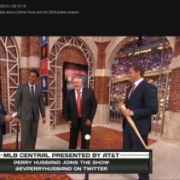
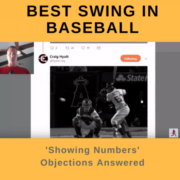
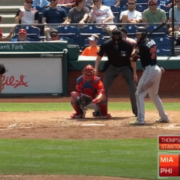
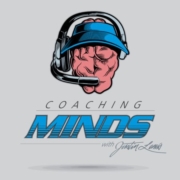
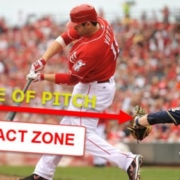
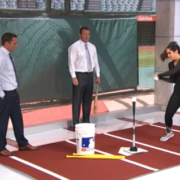

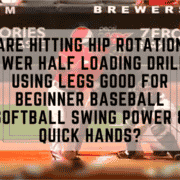



Thank you Homer and Joey for a great interview. Immediately taking away Hitting Zone communication and focus.
Glad you like Homer’s stuff Corey 😀
Can you explain this? I thought I had heard it all and now you are supporting someone who does not think power comes from your core? . Rotating the back hip through the zone is necessary for power.
Hey Jon, I understand your confusion. Be careful the words you choose…Homer didn’t say power doesn’t come from the “core”. Homer said that power doesn’t come from getting the back hip through. The pelvis is a piece of the core, 1/3 of it actually…the fascial tissue, spine, and muscles between the shoulders and pelvis is the other 1/3, and the shoulders make up the last 1/3. My hitters use the pelvis for batted ball direction, and as a tether point for loading/unloading of the shoulders. Next week’s blog post will answer your questions about this, so I won’t go into a full dissertation on it, so you’ll just have to be patient 😉
Thanks for your reply and I look forward to next week’s post.
I bet you want your hitters to get their tether point (hips) through the zone or else they would never reap any benefits from upper and lower body separation.
Jon, what do you mean by through the zone? And are you saying the hips (pelvis) should “get through” to the same point on every single pitch: inside, middle, outside? Upper and lower body separation naturally happens when we walk or run. However, quite a few hitting coaches out there forget about the function of the shoulders, and/or totally disregard their action. This week’s post will clear things up for you Jon, for sure.
Shoulders? What’s this you speak off… Next you’ll be talking about armpits and weird muscles around them than perhaps my little forearms…I thought it’s all in the hips ?….
Nice article… Looking forward to your next one. Thanks.
~DM
By the way Joey… Just because it OUGHT to naturally happen doesn’t mean everyone LETS it happen… Walking is one of those funny things… I’ve been doing it since I can remember… Of course Im doing it right…. Right?
Right? There’s no way I’ve been doing it wrong. I’m an engineer… Of course not….What’s this I hear…science…
Later…
~DM
In your comments you listed many things for describing the “core”…. Huh… Labeling… Terms… Cues……. You know me… I would love to redefine it all in light of the science and just the better understanding we have today… But that will never happen…
What I really wanted to do was give a shout out to the forgotten ribcage…. What I noticed is… If you thought of the ribcage in human movements… Those people get over a hump… Sort off… At least I can say those people have a bigger picture of what’s going on… If you read ribcage and think… What the hell am I talking about… I’m telling you… I hate to assume but you “have to” be missing a teaching that may be critical…. So Joey I know you know your stuff… Perhaps a video giving a little love for the ribcage may be interesting… Perhaps looking into what the ribcage does during the swing, load, hitch, stance…Etc… Relative to let’s say a wild guess the pelvis may be interesting…
Alright sorry to go on forever but it seems like your the only qualified person to discuss this stuff and relate it to baseball without losing most of us… Just an idea… Later. Hope all is well…
~DM